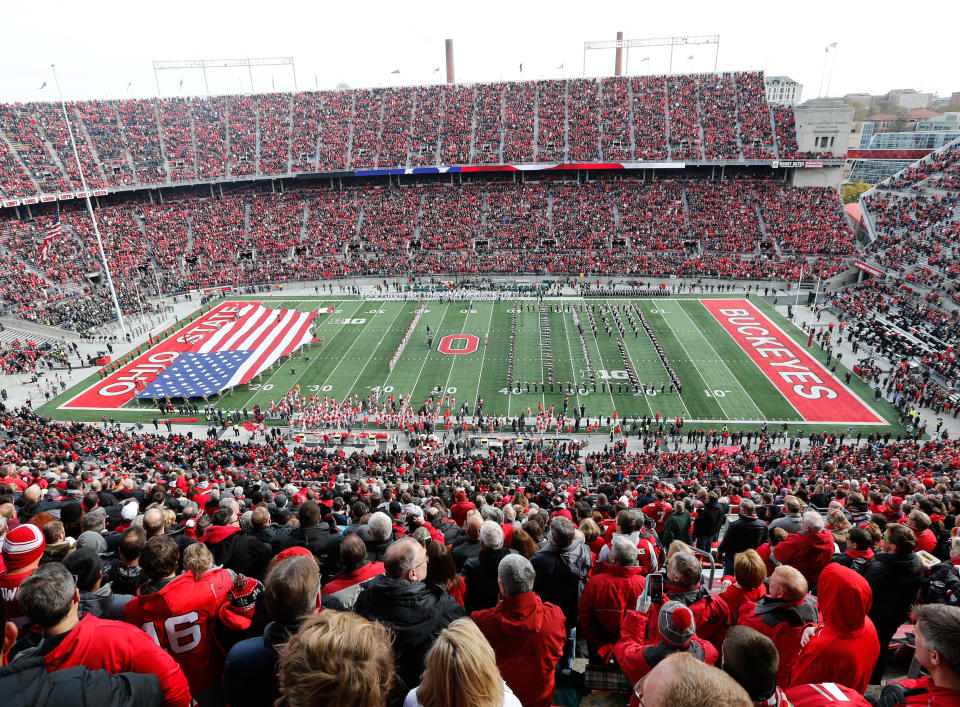Big Ten canceling non-conference games a sobering moment for college football
College football’s house of cards of a 2020 season collapsed on Thursday. In this case, it was by design — a voluntary and preemptive reshuffling and retreat.
The Big Ten announced it was packing up and building its own place — canceling all non-conference games and playing a league only slate of nine, or maybe 10 contests. It’s an attempt to maximize control in the hope that it might make it through the COVID-19 pandemic.
No one knows if it will work, but smaller, swifter and more cautious seems to make sense.
The Pac-12 and ACC will reportedly soon follow and with that, you can expect just about everyone to do the same. This is no longer about normalcy. This is about salvaging whatever you can, like a reopened restaurant with a downsized menu.
“Just trying to keep the lights on,” said one ACC athletic director. “‘Trying’ is the key word.”
Multiple sources expressed pessimism that any season will be played. Others are more hopeful that somehow this works. They all want a season. They all need it. They are all desperate for the revenue it will produce, but at this point, the task feels daunting.
“We may not have sports in the fall,” Big Ten commissioner Kevin Warren said on the Big Ten Network. “We may not have a college football season.”
"We made a vow early on that, first and foremost, we would put the health, the safety and the wellness of our student-athletes at the center of all of our decisions."
Kevin Warren talks the timing of the @bigten's decision, and what comes next. pic.twitter.com/D0Y4GXXnAz— Big Ten Network (@BigTenNetwork) July 9, 2020
There is no way to isolate the players on college campuses, which are expected to be overrun by the coronavirus, if they allow students at all.
Going to a nine-game schedule and simplifying things is the best route. There are some great non-conference games that will be lost, including longtime rivalries (no Florida-Florida State or Iowa-Iowa State?). That’s better than giving up the whole season.
The ACC is expected to give Notre Dame, which is an independent, a safe harbor and keep the six games the Irish are scheduled to play against league schools (Notre Dame delivers huge television numbers, after all). If the Irish still play scheduled games against Navy and Western Michigan (or adds someone else) then it’ll be fine.
As for the bowls and the playoffs, that’s anyone’s guess. The committee could still pick the best four teams, although with less data. Do they even play in December and January? Do they still go to a neutral bowl site?
It’s so far off, it’s impossible to predict the state of the world.
“We just want to get the season started and see where it goes,” said an SEC athletic director.
Since the pandemic hit and caused the cancellation of March Madness, those inside college athletics have been in a panic about football. No matter the bold pronouncements from some coaches or the shouts of some fans and media, nothing has ever felt safe to those making the decisions.

Sports organizations around the world are battling to play their games, but perhaps none is as difficult as major college football. There are 130 teams in the FBS, the sport’s top division. They hail from 43 states and represent big public schools and small private ones, military academies and religious institutions, big cities and small towns.
Worse, there is no central authority. No nationwide commissioner. No governing body. The NCAA just regulates, but the sport is carved up into fiefdoms. Now everyone is sticking with their own and hoping to make it as long as they can to cash as many checks as possible.
If so, they can survive somewhat intact. If not, who knows? Stanford cut 11 sports on Wednesday. That will be the norm, not the exception, even if a full season is played.
College athletics have watched revenue steadily — sometimes spectacularly — climb for decades on end. There are no recessions, no downturns, no budget crunches. Not in any major way, at least. Salaries always get bigger, facilities always get grander, leagues always expand.
So they spent the money. Now they need it to meet payroll, avoid cutting teams and paying debt service on stadiums and practice facilities that are more opulent than some in the NFL.
“No football is Armageddon,” an athletic director texted.
So they decided to play fewer games and allow for more flexibility. If a game gets canceled, maybe this way it can be made up. Hopefully it works.
If not, they can attempt to move the season to spring, but that provides no more certainty and brings a host of new challenges.
Killing the non-conference made sense, especially since the majority of those games are just money grabs — paying a weaker opponent to come in and get beat up so you can sell tickets. If stadiums aren’t at capacity, or completely empty, then why bother? (Tough break for those smaller schools, of course).
College football is a sport that is often drunk — on the drama, on the rivalries, on egos ... and, of course, out at the tailgates. It’s a wild soap opera that no one could (or would) invent. The imperfections make it perfect.
Thursday was a sober day for the sport, the realization that a new plan was needed. Here’s hoping it’s the last setback, not the first of many.
More from Yahoo Sports:

